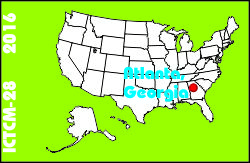
Electronic Proceedings of the Twenty-eighth Annual International Conference on Technology in Collegiate MathematicsAtlanta, Georgia, March 10-13, 2016Paper A041
Online Instructional Intervention in a Seated General Education Mathematics Course |
Regina Stone-HernandezUniversity of Mount Olive rstone-hernandez@umo.edu | Robert L. WatsonUniversity of Mount Olive rwatson@umo.edu list of all papers by this author | Jared MillerUniversity of Mount Olive JEM4303@moc.edu |
| Click to access this paper: |
ABSTRACT
Nontraditional learners represent the majority of college enrollment today (Bean & Metzner, 1985; Donaldson & Graham, 1999; Merriam & Caffarella, 1991; Remedios & Richardson, 2013). Yet, academic interventions offered for traditional seated college courses may not be adaptable for the nontraditional classes. The reasons for this discrepancy may include time constraints of the learners (Hout, 2012; Donaldson & Graham, 1999), inaccessibility to the traditional campus services (Samuels, Beach & Palmer, 2012), and the evidence that the nontraditional learner often does not identify or relate to their traditional counterparts on a socio, psycho, or economic level (Levine, 1993). Technology has proved to be a successful form of delivery for academic interventions in the traditional seated classrooms. Using technology to deliver real time, synchronous tutoring and supplemental instruction via Internet has positively affected course mastery (Blanc, DeBuhr, & Martin, 1983). However, colleges have been reluctant to integrate technology into the nontraditional classroom because of a perceived lack of mastery of or comfort with technology on the part of their students (Dearnley, Dunn, & Watson, 2006). For this reason, higher education institutions have considered nontraditional learners reluctant to enroll in online or hybrid courses (Shaw, 2005). Therefore, the nontraditional learner is limited in the interventions available for academic success, especially proactive services, equitable to their seated counterparts (Rovai, 2003). This lack of support for the nontraditional learner translates into a higher rate of enrollment attrition (Diaz, 2002; and Allen & Seaman, 2007) We will demonstrate how instructional intervention with technology in an online format for a seated, nontraditional course can be achieved in a manner that is equitable to the interventions in a traditional class. We will outline the tools used, how these were implemented, and their impact upon student content mastery as reflected in the data collected. Furthermore, we will propose how these methods could be applied to online courses for nontraditional students.Keyword(s): on-line access, pedagogy
